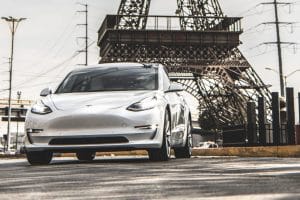Polestar plans to demonstrate its Smart Eye driver monitoring technology in January at the Consumer Electronics Show (CES) in Las Vegas.
Polestar’s Smart Eye technology is designed using two closed-loop premium driver monitoring cameras that track head, eye, and eyelid movements and trigger warning sounds or messages, or even go as far as bringing the car to a stop if the system detects a distracted, drowsy, or disconnected driver. Smart Eye, in conjunction with other standard Driver Assistance features like Lane Keeping, Adaptive Cruise Control, and more, helps to keep drivers safe.
Polestar plans to display to visitors how the Smart Eye system utilizes AI software to detect driver attentiveness in real time and how it tracks head and eye movements to determine if an operator is paying attention and engaged in driving behaviors.
“This technology addresses some of the main reasons behind fatal accidents and can help save lives by prompting the driver to refocus attention on the road – and can initiate preventive action when they don’t, or can’t,” Thomas Ingenlath, Polestar’s CEO, said.
The development of driver monitoring systems has helped decrease instances of distracted driving. The technology is advantageous in multiple applications, especially as semi-autonomous driving systems and more advanced ADAS systems have come to the market.
In vehicles not equipped with semi-autonomous driving functionality, driver monitoring systems can help keep drivers’ eyes on the road and off of things like cell phones, which are a leading cause of distracted driving accidents in the United States. The NHTSA said 3,142 people were killed due to distracted driving in 2020.
The systems are also hugely effective in cars that feature semi-autonomous driving. Although these systems allow drivers to relinquish certain responsibilities like speed control or lane keeping, they are not fully autonomous and still require the operator’s attention. Unfortunately, some drivers take advantage of these features and use them irresponsibly, which is where systems like Smart Eye will come in.
Polestar is not the first and will certainly not be the last automaker to employ these systems to keep drivers safe. Tesla activated cabin-facing cameras to monitor driver behavior in mid-2020. General Motors has driver monitoring systems for its Super Cruise system. Ford also has driver monitoring for its BlueCruise. Lucid has driver monitoring as a primary focus of its DreamDrive suite. It’s only a matter of time before more automakers adopt camera or AI-based driver monitoring systems.
Generally, driver monitoring systems help keep drivers safe. They are more effective than things like steering wheel sensors as they can be cheated with various methods, including vehicle-specific cheat devices. Educating drivers on how the systems work and how they keep operators accountable is essential. Polestar’s demonstration will likely lead to a better understanding of how technology and AI can lead to safer roads.





